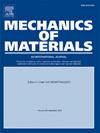A hyperelastic model for hollow fiber-reinforced composites at finite deformation
IF 3.4
3区 材料科学
Q2 MATERIALS SCIENCE, MULTIDISCIPLINARY
引用次数: 0
Abstract
This study introduces a micromechanics-based constitutive model to describe the effective hyperelastic behaviors of hollow fiber-reinforced composites under finite deformation. The multiplicative decomposition approach is employed to decompose a general deformation into three fundamental deformations: isochoric uniaxial deformation along the fiber direction, equi-biaxial deformation on the transverse plane, and pure shear deformation. Based on this multiplicative decomposition, the free energy density function of the composites is thus additively decomposed into the three corresponding components. Subsequently, the effective free energy density functions of the composite for triaxial deformation (composed of the isochoric uniaxial deformation along the fiber direction and equi-biaxial deformation on the transverse plane), along-fiber shear, and transverse shear are derived using a cylindrical composite element model. The total free energy density function of the composite is then obtained by summing the contributions of these decomposed deformations. To validate the proposed model, finite element simulations based on representative volume elements are conducted. The effects of fiber volume fraction, fiber/matrix stiffness ratio, and wall thickness of hollow fiber on the effective mechanical behaviors of the composites are explored. The theoretical predictions show excellent agreement with numerical results for all considered cases, demonstrating that the proposed model reliably predicts the effective mechanical response of hollow fiber-reinforced composites under finite deformation. Finally, to further validate the prediction accuracy and computational efficiency of the developed model, it is applied to the structural analysis of a cantilever beam, with results compared to those obtained using the FE2 method. This comparative analysis demonstrates again the accuracy and efficiency of the proposed approach in practical structural analysis.
有限变形下中空纤维增强复合材料的超弹性模型
本文引入基于细观力学的本构模型来描述有限变形下中空纤维增强复合材料的有效超弹性行为。采用乘法分解方法,将一般变形分解为沿纤维方向等时向单轴变形、横向等双轴变形和纯剪切变形三种基本变形。基于这种乘法分解,将复合材料的自由能密度函数相加分解为三个相应的分量。随后,利用柱状复合材料单元模型推导了复合材料在三轴变形(由沿纤维方向等时单轴变形和横向等双轴变形组成)、沿纤维剪切和横向剪切时的有效自由能密度函数。然后通过对这些分解变形的贡献求和得到复合材料的总自由能密度函数。为了验证所提出的模型,进行了基于代表性体积单元的有限元仿真。探讨了纤维体积分数、纤维/基体刚度比和中空纤维壁厚对复合材料有效力学行为的影响。在所有考虑的情况下,理论预测结果与数值结果吻合良好,表明所提出的模型可靠地预测了有限变形下空心纤维增强复合材料的有效力学响应。最后,为了进一步验证所建立模型的预测精度和计算效率,将该模型应用于某悬臂梁的结构分析,并与FE2方法的结果进行了比较。这一对比分析再次证明了该方法在实际结构分析中的准确性和有效性。
本文章由计算机程序翻译,如有差异,请以英文原文为准。
求助全文
约1分钟内获得全文
求助全文
来源期刊

Mechanics of Materials
工程技术-材料科学:综合
CiteScore
7.60
自引率
5.10%
发文量
243
审稿时长
46 days
期刊介绍:
Mechanics of Materials is a forum for original scientific research on the flow, fracture, and general constitutive behavior of geophysical, geotechnical and technological materials, with balanced coverage of advanced technological and natural materials, with balanced coverage of theoretical, experimental, and field investigations. Of special concern are macroscopic predictions based on microscopic models, identification of microscopic structures from limited overall macroscopic data, experimental and field results that lead to fundamental understanding of the behavior of materials, and coordinated experimental and analytical investigations that culminate in theories with predictive quality.
 求助内容:
求助内容: 应助结果提醒方式:
应助结果提醒方式:


